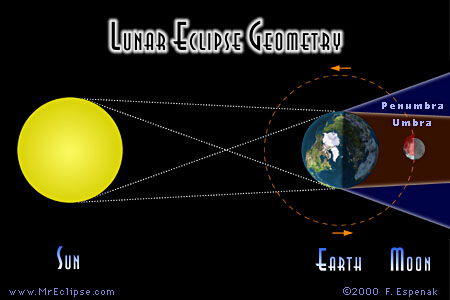
A solar eclipse occurs when the Moon passes between the Earth and the Sun, temporarily blocking out the Sun. The people on Earth who observe a solar eclipse are standing in the Moon's shadow.

The moon must be in the New phase in order to have a solar eclipse!
A lunar eclipse occurs when the Earth's shadow is cast on the Moon.

Question: What lunar phase would it be if we are seeing a lunar eclipse?
If the Earth had no atmosphere, then the Moon would turn completely black during a lunar eclipse. However, the Earth's atmosphere bends light through it, scattering the blue light but letting the red light pass, and this refracted, or bent, red light reaches the Moon, giving it a reddish appearance during a lunar eclipse. Here are some lunar eclipse pictures.
Question: Why don't we see a lunar and/or solar eclipse every month, since the Moon goes through all of its phases each month?
In fact, we are extremely fortunate to live on Earth with a Moon of the exact right size to have eclipses. The Moon is 400 times smaller than the Sun, but it is also 400 times closer than the Sun. The result is that the Moon and the Sun have the same apparent size in the sky (building analogy).
Here is a good resource web page if you are interested in learning more about eclipses or finding out when you can see the next one from New Mexico.